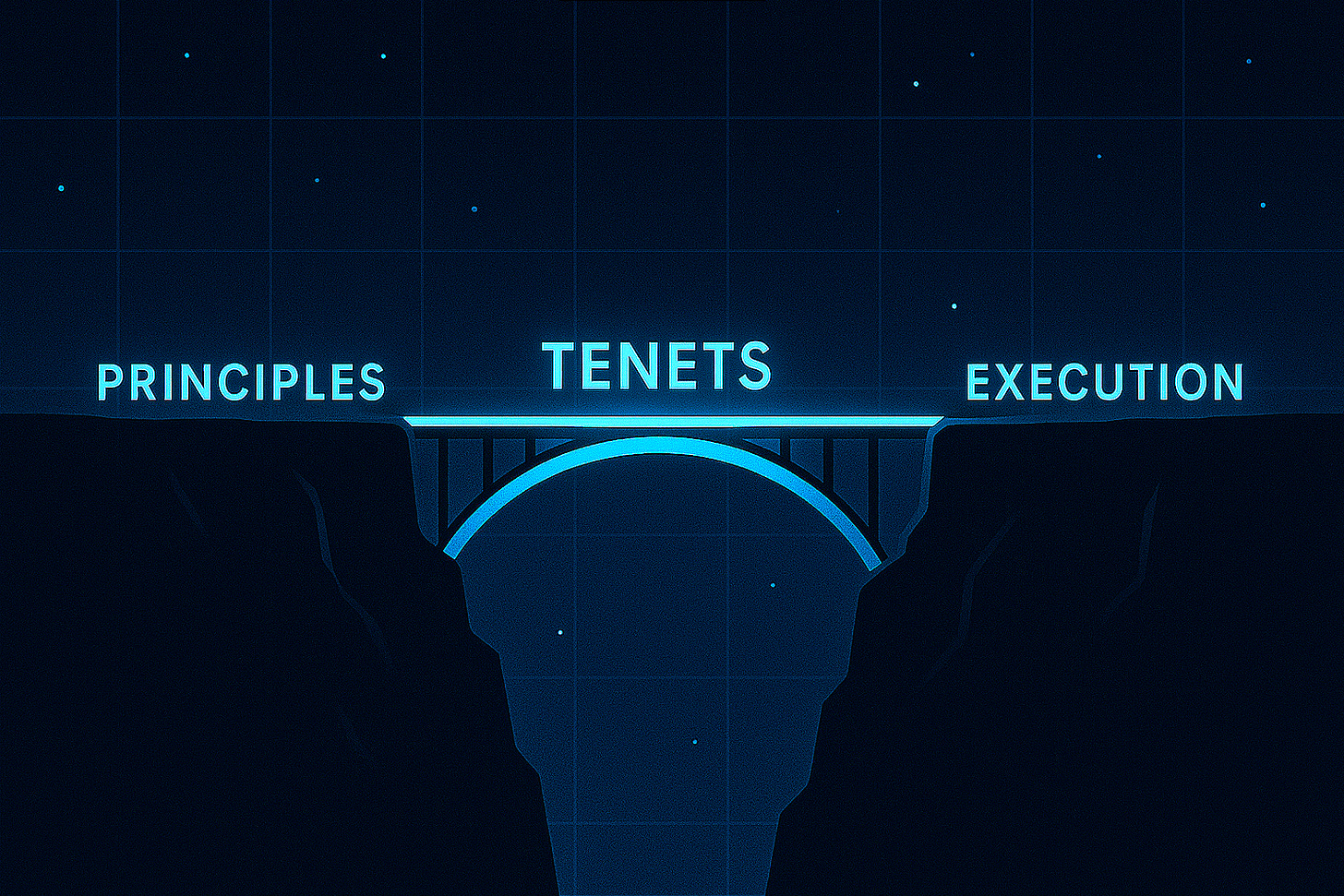The Design Rules You Didn’t Write Down
#026: And why your design team is slower and ships lower quality work without them.
I hold a personal tenet for information architecture and wayfinding:
“No ‘junk drawer’ navigation should exist — hamburger menus or otherwise.”
When design teams falter, it’s rarely because they lack vision or execution. More often, the problem lies in the space between: the missing middle layer that connects strategy to everyday decisions.
At the top, we set principles — broad, directional statements that act as part of our design north star. At the bottom, we focus on execution — pixels, components, tickets, and pull requests.
But what fills the space in between, when tradeoffs are inevitable and the “right” choice isn’t obvious?
That’s where tenets come in.
Principles vs. Tenets
Principles are broad and durable. They define what we value as a design organization. Example: “Flexible scalability.”
Tenets are sharp, contextual, and highly opinionated. They ladder up to principles and provide a lens for making real-world tradeoffs. Example: “Users must opt into complexity.”
On its own, “Flexible scalability” is memorable — but it doesn’t tell you how to make a call when complexity creeps in. The tenet makes it concrete: don’t assume complexity is acceptable unless the user chooses it.
Bob Baxley recalled Steve Jobs’ tenet for the first Keynote team on Lenny’s Podcast:
“Innovation over PowerPoint compatibility.”
That single line gave the team permission to prioritize bold choices. Compatibility mattered, but innovation mattered more and scale could come later.
I hold a personal tenet for information architecture and wayfinding:
“No ‘junk drawer’ navigation should exist — hamburger menus or otherwise.”
Clear navigation shouldn’t rely on a catch-all “more” menu. That’s a design team conceding that their taxonomy failed.
Real-World Tenets in Action
Amazon Prime: A principle might be “Frictionless commerce.” A tenet underneath it is “One-click purchasing should never require re-confirmation.” This sharp rule led directly to Amazon’s 1-Click patent, which defined e-commerce for a decade.
Airbnb: A principle might be “Trust between strangers.” A tenet underneath could be “Profiles must show authentic, user-generated photos.” This decision — avoiding stock imagery or avatars — built credibility early on and differentiated them from competitors.
Apple iPhone: A principle might be “Seamless user experience.” A tenet: “No physical keyboard.” That tradeoff was radical in 2007, but it anchored the product’s identity.
Netflix: A principle might be “Personalized discovery.” A tenet underneath it: “Default to recommendations over search.” Research shows that over 80% of Netflix viewing comes from recommendations, not user search — because they built around this tenet.
Principles + Tenets as Forward-Looking Heuristics
Think about Jakob Nielsen’s 10 usability heuristics, e.g., “Visibility of system status.” All are critically important, but as a “tablestakes” foundation. They set the minimum bar for usable design and should be non-negotiable in the vast majority of cases.
Principles and tenets extend upon those heuristics, often is a more aspirational way that helps define what design means to an organizaiton. They aren’t about what must not be broken — they articulate how an organization will inspire, differentiate, and innovate.
Heuristics = baseline quality (e.g., “visibility of system status”).
Principles + Tenets = strategic tradeoffs (e.g., “users must opt into complexity”).
Together, they should drive every critical design conversation in your org — from the smallest team critique to the executive strategy review. I’ve found that being clear on this point and modeling the use of usability heuristics and principle + tenets in my own feedback helps build a “first principles” design and decision-making culture that scales.
Why This Matters for Leaders
If your org lacks tenets, you’ll see:
Inconsistent decisions across teams facing similar challenges.
Endless debates with no common ground.
Dilution of vision as strategy gets chipped away by compromise.
But with tenets, you get velocity and alignment as they give teams permission to say: When forced to choose, here’s how we decide.
What’s one tenet your team lives by today? And if you don’t have one… what decision do you wish was already decided for you?



